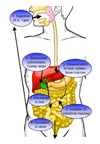Contrasting persistence strategies in Salmonella and Mycobacterium
- PMID: 20056478
- PMCID: PMC2822150
- DOI: 10.1016/j.mib.2009.12.007
Contrasting persistence strategies in Salmonella and Mycobacterium
Abstract
Long-term survival of persistent bacterial pathogens in mammalian hosts critically depends on their ability to avoid elimination by innate and adaptive immune responses. The persistent human pathogens that cause typhoid fever and tuberculosis exemplify alternative strategies for survival in the host: immune evasion and immune adaptation, respectively. Salmonella enterica serotype Typhi evades host innate immune responses and inflammation by expressing factors that interfere with its detection as a Gram-negative bacterium, enabling persistent colonization of an immunologically privileged niche, the gallbladder. In contrast, Mycobacterium tuberculosis has adapted to survive within phagocytic cells, which typically eliminate invading microbes, by deploying stress resistance mechanisms that counteract the harsh environment of the phagolysosome.
Copyright 2009 Elsevier Ltd. All rights reserved.
Figures


Similar articles
-
Immune responses to intracellular bacteria.Curr Opin Immunol. 2001 Aug;13(4):417-28. doi: 10.1016/s0952-7915(00)00236-3. Curr Opin Immunol. 2001. PMID: 11498297 Review.
-
Persistent bacterial infections: the interface of the pathogen and the host immune system.Nat Rev Microbiol. 2004 Sep;2(9):747-65. doi: 10.1038/nrmicro955. Nat Rev Microbiol. 2004. PMID: 15372085 Review.
-
Loss of very-long O-antigen chains optimizes capsule-mediated immune evasion by Salmonella enterica serovar Typhi.mBio. 2013 Jul 16;4(4):e00232-13. doi: 10.1128/mBio.00232-13. mBio. 2013. PMID: 23860765 Free PMC article.
-
Typhoid fever: "you can't hit what you can't see".Gut Microbes. 2012 Mar-Apr;3(2):88-92. doi: 10.4161/gmic.18602. Epub 2012 Mar 1. Gut Microbes. 2012. PMID: 22156762 Free PMC article. Review.
-
Virulence factors of Salmonella Typhi: interplay between the bacteria and host macrophages.Arch Microbiol. 2025 Mar 17;207(4):89. doi: 10.1007/s00203-025-04297-0. Arch Microbiol. 2025. PMID: 40095029 Review.
Cited by
-
Fellutamide B is a potent inhibitor of the Mycobacterium tuberculosis proteasome.Arch Biochem Biophys. 2010 Sep 15;501(2):214-20. doi: 10.1016/j.abb.2010.06.009. Epub 2010 Jun 15. Arch Biochem Biophys. 2010. PMID: 20558127 Free PMC article.
-
CD4 T cells promote rather than control tuberculosis in the absence of PD-1-mediated inhibition.J Immunol. 2011 Feb 1;186(3):1598-607. doi: 10.4049/jimmunol.1003304. Epub 2010 Dec 20. J Immunol. 2011. PMID: 21172867 Free PMC article.
-
Characterization of a single-stranded DNA binding protein from Salmonella enterica serovar Typhimurium LT2.Protein J. 2011 Feb;30(2):102-8. doi: 10.1007/s10930-011-9309-1. Protein J. 2011. PMID: 21267641
-
Localization of acidic phospholipid cardiolipin and DnaA in mycobacteria.Tuberculosis (Edinb). 2011 Dec;91 Suppl 1:S150-5. doi: 10.1016/j.tube.2011.10.025. Epub 2011 Dec 3. Tuberculosis (Edinb). 2011. PMID: 22142462 Free PMC article.
-
Selective culling of high avidity antigen-specific CD4+ T cells after virulent Salmonella infection.Immunology. 2011 Dec;134(4):487-97. doi: 10.1111/j.1365-2567.2011.03510.x. Immunology. 2011. PMID: 22044420 Free PMC article.
References
-
- Young D, Hussell T, Dougan G. Chronic bacterial infections: living with unwanted guests. Nat. Immunol. 2002;3:1026–1032. - PubMed
-
- Monack DM, Mueller A, Falkow S. Persistent bacterial infections: the interface of the pathogen and the host immune system. Nat. Rev. Microbiol. 2004;2:747–765. - PubMed
-
- Parry CM, Hien TT, Dougan G, White N, Farrar JJ. Typhoid fever. N. Engl. J. Med. 2002;347:1770–1782. - PubMed
-
- Lillebaek T, Dirksen A, Vynnycky E, Baess I, Thomsen VØ, Andersen AB. Stability of DNA patterns and evidence of Mycobacterium tuberculosis reactivation occurring decades after the initial infection. J. Infect. Dis. 2003;188:1032–1039. - PubMed
-
- Lillebaek T, Dirksen A, Baess I, Strunge B, Thomsen VØ, Andersen AB. Molecular evidence of endogenous reactivation of Mycobacterium tuberculosis after 33 years of latent infection. J. Infect. Dis. 2002;185:401–404. - PubMed
Publication types
MeSH terms
Grants and funding
LinkOut - more resources
Full Text Sources

